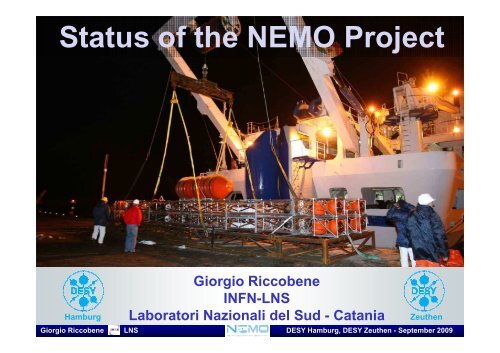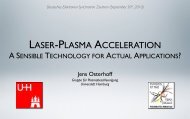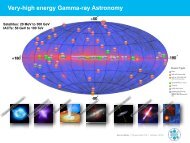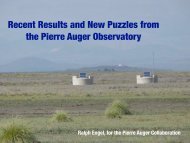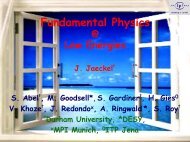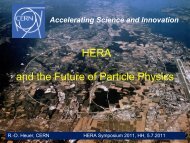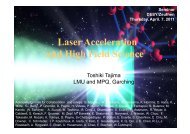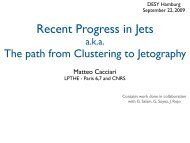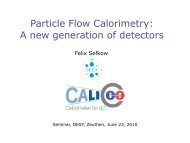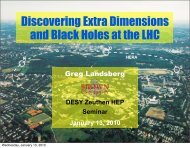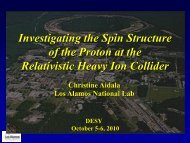Giorgio Riccobene.pdf - Physics Seminar - Desy
Giorgio Riccobene.pdf - Physics Seminar - Desy
Giorgio Riccobene.pdf - Physics Seminar - Desy
Create successful ePaper yourself
Turn your PDF publications into a flip-book with our unique Google optimized e-Paper software.
Status of the NEMO Project<br />
Hamburg<br />
<strong>Giorgio</strong> <strong>Riccobene</strong><br />
INFN-LNS<br />
Laboratori Nazionali del Sud - Catania Zeuthen<br />
<strong>Giorgio</strong> <strong>Riccobene</strong> LNS DESY Hamburg, DESY Zeuthen - September 2009
Outline of the talk<br />
A (short) introduction on HE neutrino astronomy:<br />
The cosmic rays, gamma and neutrino connection<br />
Underwater Cherenkov neutrino detectors<br />
The NEMO (Neutrino Mediterranean Observatory) Project<br />
Deep Sae site seek and characterisation<br />
Architecture<br />
Phase 1<br />
Phase 2<br />
NEMO and KM3NeT<br />
<strong>Giorgio</strong> <strong>Riccobene</strong> LNS DESY Hamburg, DESY Zeuthen - September 2009
Spectrum: E -2.7<br />
At almost all energies<br />
The CR Spectrum<br />
• E10 3 GeV<br />
indirect detection<br />
KASKADE, EAS-TOP,...<br />
KASCADE-GRANDE<br />
• E>10 8 GeV<br />
EAS, N 2,Cherenkov<br />
AGASA, Fly’s Eye, HiRes<br />
• E>10 10 GeV<br />
Combined techniques: Auger<br />
<strong>Giorgio</strong> <strong>Riccobene</strong> LNS DESY Hamburg, DESY Zeuthen - September 2009
The Fermi Acceleration Mechanism<br />
Observed E -2.7 spectrum<br />
Non-thermal spectrum. Statistical acceleration<br />
Fermi’s idea:<br />
Particles gain energy hitting on clouds moving at V«c (inefficient)<br />
Bell’s shock acceleration (E -2 ) :<br />
Each time a particle hit on the shock front it gains energy<br />
charged particles are confined by the object magnetic field<br />
maximum energy∝∝∝∝ number of hits ∝∝∝∝ (confinement) B x R<br />
Shock wave produced<br />
by the detonation of a<br />
TNT charge<br />
Shock<br />
front<br />
Hot and dense<br />
upstream<br />
Magnetic<br />
field<br />
Cold downstream<br />
Shock front<br />
particle<br />
walk<br />
SNR 1006<br />
<strong>Giorgio</strong> <strong>Riccobene</strong> LNS DESY Hamburg, DESY Zeuthen - September 2009
The Hillas’ Plot<br />
18<br />
Emax ≈ ≈ β βshock Z ⋅ ⋅ B[ μ μG] ⋅ ⋅ R[kpc] ⋅<br />
⋅10<br />
eV<br />
dN<br />
∝ E<br />
dE<br />
−2<br />
Galactic SNR:<br />
E max ≈≈≈≈ 100 TeV x Z<br />
Fermi acceleration to Ultra and<br />
Extra high energies requires:<br />
• Large cosmic objects<br />
• Intense magnetic field<br />
• High shockwave velocity<br />
Candidate extragalactic sources:<br />
AGN and GRB<br />
<strong>Giorgio</strong> <strong>Riccobene</strong> LNS DESY Hamburg, DESY Zeuthen - September 2009<br />
AGN<br />
GRB
CR Origin: the Standard Scenario<br />
Galactic protons:<br />
accelerated in SNR<br />
and confined in the<br />
Galaxy<br />
(d=100 pc, B =3μμμμG)<br />
dN/dE ∝∝∝∝ E -2.1 ⋅⋅⋅⋅ E -0.6<br />
Gaisser<br />
Knee<br />
Galactic<br />
nuclei<br />
Ankle<br />
Extragalactic<br />
hadrons<br />
Sources of high energy hadrons exists and<br />
they dominate the CR spectrum<br />
Cut-off<br />
<strong>Giorgio</strong> <strong>Riccobene</strong> LNS DESY Hamburg, DESY Zeuthen - September 2009
ECMBR ~ 6.6·10-4 2 2<br />
mΔ mN<br />
EpECMBR 2<br />
eV<br />
−<br />
≥<br />
E p ~ 10 19.5 eV<br />
nCMBR ~ 400 cm-3 nCMBR ~ 400 cm<br />
GZK effect and BZ neutrinos<br />
Nγ CMBR → Δ + → Nπ (GZK: Greisen Zatsepin Kuzmin)<br />
σ pγ~ 100 μbarn<br />
pCMBR<br />
λ λ λ att = =<br />
σ<br />
1<br />
n<br />
pγ CMBR<br />
The Astrophysical Beam Dump<br />
Fermi acceleration of protons and electrons in astrophysical sources<br />
Particle accelerator<br />
Spectrum dN p,e/dE ∝ E -2<br />
Leptonic HE γ production<br />
synchrotron radiation followed by IC<br />
e + γ Synchrotron e’ + γ’ HE<br />
Hadronic HE ν and γ production<br />
p + p (SNR,X-Ray Binaries) X,π<br />
p + γ (AGN, GRB, µQSO) Nπ<br />
Decay of pions and muons<br />
neutral pions HE gammas<br />
charged pions HE neutrinos<br />
Astrophysical jet<br />
<strong>Giorgio</strong> <strong>Riccobene</strong> LNS DESY Hamburg, DESY Zeuthen - September 2009
First Hadronic Gamma Ray Source detection ? (HESS)<br />
The Case of Galactic SNR RXJ1713.7-3946<br />
proton acceleration + beam dump on nearby molecular clouds (dense target for VHE p)<br />
• Gammas observed up to several tens TeV<br />
• Spectrum features hardly explainable with IC mechanisms<br />
Neutrinos are the smoking gun for hadronic processes<br />
HESS Data<br />
Amato et al. gammas<br />
Volk, Berzhko gammas<br />
Vissani et al. neutrinos<br />
Amato et al. neutrinos<br />
<strong>Giorgio</strong> <strong>Riccobene</strong> LNS DESY Hamburg, DESY Zeuthen - September 2009
The far universe is opaque to UHE gammas and protons<br />
Highest energy<br />
protons<br />
Highest energy<br />
gamma rays<br />
gamma energy degradation<br />
3C279, z= 0.536<br />
proton energy degradation<br />
Only neutrinos can reach the Earth from cosmological sources<br />
<strong>Giorgio</strong> <strong>Riccobene</strong> LNS DESY Hamburg, DESY Zeuthen - September 2009
Limits for UHE protons and Gamma Ray Astronomy<br />
Astrophysical<br />
source<br />
Low energy protons<br />
deflected<br />
High energy protons<br />
5·10Mpc<br />
High energy gammas<br />
10 Mpc<br />
neutrinos<br />
<strong>Giorgio</strong> <strong>Riccobene</strong> LNS DESY Hamburg, DESY Zeuthen - September 2009
Motivations for high energy neutrino astronomy<br />
• Extend the high energy CR and γ Horizon (>GZK limit)<br />
• Identify the sources of CR<br />
• Explore deep inside the source (where τ »1 for CR and γ)<br />
• Probe hadronic models in astrophysical sources<br />
<strong>Giorgio</strong> <strong>Riccobene</strong> LNS DESY Hamburg, DESY Zeuthen - September 2009<br />
τ
Neutrino fluxes: known and unknown<br />
Unexplored Unexplored<br />
<strong>Giorgio</strong> <strong>Riccobene</strong> LNS DESY Hamburg, DESY Zeuthen - September 2009
Very Large Volume Neutrino Detectors<br />
The requirement of large neutrino interaction target<br />
induced Markov and Zheleznykh to propose the use<br />
of natural targets.<br />
Deep seawater and polar ice offers:<br />
• huge (and inexpensive) target for neutrino interaction;<br />
• shielding from cosmic background;<br />
• good characteristics as optical and radio Cherenkov<br />
radiators;<br />
• good characteristics as acoustic wave propagators<br />
<strong>Giorgio</strong> <strong>Riccobene</strong> LNS DESY Hamburg, DESY Zeuthen - September 2009
High Energy neutrinos detection techniques<br />
1 TeV 100 PeV 1000 ZeV<br />
ν μ<br />
Optical Detection<br />
(ICECUBE-KM3NeT)<br />
μ<br />
Medium: Seawater, Polar Ice<br />
ν μ (throughgoing and contained)<br />
ν e,τ (contained cascades)<br />
Carrier: Cherenkov Light (UV-visible)<br />
Attenuation length: 100 m<br />
Sensor: PMTs<br />
Instrumented Volume: 1 km 3<br />
Radio Detection<br />
(RICE, SALSA, ICERAY)<br />
ν<br />
hadronic and /or<br />
em cascade<br />
Medium: Salt domes, Polar Ice<br />
ν (cascades)<br />
Carrier: Cherenkov Radio<br />
Attenuation length: 1 km<br />
Sensors: Antennas<br />
Instrumented Volume: >10 km 3<br />
ν<br />
hadronic<br />
cascade<br />
Acoustic Detection<br />
(Prototypes)<br />
Medium: Seawater, Polar Ice,<br />
Salt Domes<br />
ν (cascades)<br />
em cascade<br />
Carrier: Sound waves (tens kHz)<br />
Attenuation length: ∼ 10 km<br />
Hydro(glacio)-phones<br />
Instrumented Volume: >100 km 3<br />
<strong>Giorgio</strong> <strong>Riccobene</strong> LNS DESY Hamburg, DESY Zeuthen - September 2009
neutrino<br />
Underwater Cherenkov detectors<br />
atmospheric<br />
muon<br />
Connection to the shore<br />
Cherenkov<br />
light<br />
~5000 PMT<br />
muon<br />
neutrino<br />
depth<br />
>3000m<br />
<strong>Giorgio</strong> <strong>Riccobene</strong> LNS DESY Hamburg, DESY Zeuthen - September 2009
The km3 telescope: a downward looking detector<br />
Neutrino telescopes search for muon tracks induced by neutrino interactions<br />
The downgoing atmospheric μμμμ flux overcomes by several orders of<br />
magnitude the expected μμμμ fluxes induced by νννν interactions.<br />
On the other hand, muons cannot<br />
travel in rock or water more than<br />
≈≈≈≈ 50 km at any energy<br />
Use the Earth as a filter<br />
Upgoing and horizontal muon<br />
tracks are neutrino signatures<br />
<strong>Giorgio</strong> <strong>Riccobene</strong> LNS DESY Hamburg, DESY Zeuthen - September 2009
Cherenkov track reconstruction<br />
Cherenkov photons emitted by the<br />
muon track are correlated by the<br />
causality relation:<br />
c(t j - t 0) = l j + d j tg( ϑc<br />
)<br />
The track can be reconstructed<br />
during offline analysis of space-<br />
time correlated PMT signals (hits).<br />
Required resolution:<br />
1 ns in time<br />
10 cm in position<br />
pseudo<br />
vertex<br />
<strong>Giorgio</strong> <strong>Riccobene</strong> LNS DESY Hamburg, DESY Zeuthen - September 2009
AMANDA and IceCube at the South Pole<br />
<strong>Giorgio</strong> <strong>Riccobene</strong> LNS DESY Hamburg, DESY Zeuthen - September 2009
The first km3-scale neutrino telescope: IceCube<br />
Completion January 2011:<br />
86 strings (60 PMT each)<br />
4800 10” PMT (only downward looking)<br />
125 m inter string distance<br />
16 m spacing along a string<br />
Instrumented volume: 1 km 3 (1 Gton)<br />
180 surface tanks for IceTop<br />
Present Status<br />
• 59 strings<br />
• 118 IceTop tanks<br />
The Detector is taking data<br />
during the construction phase.<br />
Adapted from A.Karle, 2009<br />
<strong>Giorgio</strong> <strong>Riccobene</strong> LNS DESY Hamburg, DESY Zeuthen - September 2009
Present Limits on Neutrino Fluxes<br />
AMANDA 2000-2007<br />
ICECUBE<br />
ICECUBE<br />
ICECUBE 3 years<br />
RICE<br />
(Ice Radio Cherenkov)<br />
HIRES (EAS)<br />
ANITA<br />
Radio Cherenkov<br />
AUGER (EAS, tau skimming)<br />
<strong>Giorgio</strong> <strong>Riccobene</strong> LNS DESY Hamburg, DESY Zeuthen - September 2009
The Mediterranean km3 detector KM3NeT<br />
There are strong scientific motivations that suggest to install two neutrino<br />
telescopes in opposite hemispheres :<br />
• Full sky coverage<br />
• Galactic Center only observable from Northern Hemisphere<br />
The most convenient location for the Northern km3 detector is the<br />
Mediterranean Sea:<br />
vicinity to infrastructures<br />
good water quality<br />
good weather conditions for sea operations<br />
<strong>Giorgio</strong> <strong>Riccobene</strong> LNS DESY Hamburg, DESY Zeuthen - September 2009
The KM3NeT Detector Target Performances<br />
KM3NeT is deep-sea research infrastructure hosting a high energy neutrino<br />
telescope to be constructed in the Mediterranean Sea.<br />
41 Universities and Research Institutes from 10 European Countries: nuclear and<br />
particle physics, astrophysics, geophysics and deep sea science.<br />
Thanks to water optical properties and larger depth KM3NeT is expected to<br />
be more sensitive than IceCube<br />
Sensitivity<br />
ANTARES 1 year<br />
KM3NeT 1 year<br />
ICECUBE 1 year<br />
<strong>Giorgio</strong> <strong>Riccobene</strong> LNS DESY Hamburg, DESY Zeuthen - September 2009
RXJ 1713.7 -3946<br />
Galactic Centre Region<br />
Mediterranenan-km3 and Icecube visibility<br />
Mediterranean<br />
telescope<br />
visibility >75%<br />
Mediterranean<br />
telescope<br />
visibility >25%<br />
Need two telescopes to cover the whole sky.<br />
The Galactic centre can be seen only from the Mediterranean telescope.<br />
Combined studies with HESS sources.<br />
<strong>Giorgio</strong> <strong>Riccobene</strong> LNS DESY Hamburg, DESY Zeuthen - September 2009
The Mediterranean km 3 detector potentials and payoffs<br />
Structures can be recovered:<br />
• The detector can be maintained<br />
• The detector geometry can be reconfigured<br />
The underwater telescope can be installed at depth ≥ 3000 m<br />
Muon background reduction<br />
Light effective scattering length (>100 m) is much longer than in ice (20 m)<br />
Cherenkov photons directionality preserved<br />
Payoffs Light must absorption be minimized length selecting in water (70 a deep m) is sea smaller site than with: in ice (100 m)<br />
long light absorption Less Cherenkov length photons detected<br />
40K low<br />
decay<br />
bioluminescence<br />
in water + bioluminescence<br />
( 40K density is almost constant in the Sea)<br />
Optical background and dead time increased<br />
low biofouling and sedimentation rates<br />
Sediments and fouling<br />
Optical modules obscuration maintenance<br />
<strong>Giorgio</strong> <strong>Riccobene</strong> LNS DESY Hamburg, DESY Zeuthen - September 2009
The Mediterranean km 3<br />
There are three collaborations active in the Mediterranean Sea:<br />
ANTARES, NEMO and NESTOR<br />
Toulon 2400 m<br />
ANTARES<br />
NEMO NESTOR<br />
Capo Passero 3500 m Pylos 3800:4500 m<br />
<strong>Giorgio</strong> <strong>Riccobene</strong> LNS DESY Hamburg, DESY Zeuthen - September 2009
NEMO – Towards the km 3<br />
INFN funded NEMO with the goal of constructing a km 3 scale<br />
underwater detector for astrophysical neutrinos in the<br />
Mediterranean Sea at >3500 m<br />
Activities:<br />
Search and characterization of deep sea sites<br />
Detector architecture design<br />
Technological demonstrator: NEMO Phase-1<br />
Realization of an infrastructure for the km3<br />
More than 80 researchers from INFN and other Italian institutes<br />
NEMO is part of the KM3NeT consortium<br />
<strong>Giorgio</strong> <strong>Riccobene</strong> LNS DESY Hamburg, DESY Zeuthen - September 2009
Site Selection and characterization activity<br />
Since 1998 more than 30 naval campaigns exploring deep sea sites in the<br />
Mediterranean Sea (and in Baikal Lake for comparison).<br />
Optimal site found about 80 km SE of Capo Passero (Sicily)<br />
Deep sea water properties in Capo Passero site have been monitored since<br />
year 2000<br />
Light optical background<br />
monitoring station<br />
Light<br />
transmissometer<br />
Biofouling<br />
monitoring station<br />
Sediment Trap<br />
<strong>Giorgio</strong> <strong>Riccobene</strong> LNS DESY Hamburg, DESY Zeuthen - September 2009
The Capo Passero Site<br />
• Depths of more than 3500 m are reached at about 80 km distance from the<br />
shore<br />
• Water optical properties are the best observed in the studied sites (L a ≈ 70 m<br />
@λλλλ = 440 nm)<br />
• Optical background from bioluminescence is extremely low (40 kHz on 10’’<br />
PMT, 0.3 s.p.e.)<br />
• Deep sea water currents are low and stable (3 cm/s avg., 10 cm/s peak)<br />
• Wide abyssal plain, far from the shelf break, allows for possible<br />
reconfiguration and large extension of the detector<br />
The site selected for the km 3<br />
detector lies on a flat and<br />
wide plateau far from the<br />
shelf break (reduced risks)<br />
CP Site<br />
<strong>Giorgio</strong> <strong>Riccobene</strong> LNS DESY Hamburg, DESY Zeuthen - September 2009
The depth issue: atmospheric muon background rejection<br />
Bugaev<br />
Downgoing muon background is<br />
strongly reduced as a function of<br />
detector installation depth.<br />
Depth >3000 m (≈1 km rock) is<br />
optimal for detector installation<br />
BAIKAL<br />
ANTARES (Toulon,France)<br />
ICECUBE (South Pole)<br />
NEMO (Capo Passero, Italy)<br />
NESTOR (Pylos, Greece)<br />
<strong>Giorgio</strong> <strong>Riccobene</strong> LNS DESY Hamburg, DESY Zeuthen - September 2009
Comparison with ANTARES and Baikal waters<br />
Optical properties have been measured in joint ANTARES-NEMO campaigns<br />
in Toulon and in Capo Passero (July-August 2002)<br />
NEMO data<br />
ANTARES data<br />
<strong>Giorgio</strong> <strong>Riccobene</strong> LNS DESY Hamburg, DESY Zeuthen - September 2009
Water transparency in Capo Passero Site<br />
temperature salinity a440 c440<br />
Seasonal dependence of<br />
oceanographical (Temperature<br />
and Salinity) and optical<br />
(absorption and attenuation)<br />
properties has been studied in<br />
Capo Passero<br />
Variations are only observed in<br />
shallow water layers<br />
Data taken in:<br />
Aug 03 (2 profiles superimposed)<br />
Aug 02 (3 profiles superimposed)<br />
Mar 02 (4 profiles superimposed)<br />
May 02 (2 profiles superimposed)<br />
Dec 99 (2 profiles superimposed)<br />
<strong>Giorgio</strong> <strong>Riccobene</strong> LNS DESY Hamburg, DESY Zeuthen - September 2009
Bioluminescence<br />
Optical Background in Capo Passero<br />
40 40<br />
-<br />
K →→ → Ca + e + νν<br />
ν νe<br />
(B.R. = 89.28%)<br />
40<br />
- 40<br />
K + + e → Ar + νν<br />
ν νe<br />
+ γ (B.R. =10.72%<br />
Increase average rate<br />
and produce bursts<br />
Potassium 40 decay<br />
)<br />
Induces a Constant rate 30 kHz<br />
(10’’ PMT @ 0.5 spe)<br />
ANTARES<br />
Capo Passero data<br />
(subset of 2 months)<br />
<strong>Giorgio</strong> <strong>Riccobene</strong> LNS DESY Hamburg, DESY Zeuthen - September 2009
Capo Passero Seascapes<br />
<strong>Giorgio</strong> <strong>Riccobene</strong> LNS DESY Hamburg, DESY Zeuthen - September 2009
NEMO Towards the Mediterranean km 3 : architecture<br />
The design of the Mediterranean km 3 detector is addressed<br />
to fit physics requirements:<br />
• Effective area ≥ 1 km 2<br />
• Angular resolution close to intrinsic resolution<br />
( ≤ 0.1°for muons produced by E ν≥10 TeV )<br />
• Energy threshold of a few 100 GeV<br />
Design detector layout and study detector performances as a<br />
function of site parameters (depth, water properties,...)<br />
<strong>Giorgio</strong> <strong>Riccobene</strong> LNS DESY Hamburg, DESY Zeuthen - September 2009
NEMO Architecture studies<br />
Design based on detector modularity<br />
• reduce the number of structures<br />
• reduce the underwater connections<br />
• allow operation with ROV and reconfigurability<br />
MEOC<br />
PJB SJB Detection Unit<br />
140 m<br />
300 m<br />
Structure Spacing<br />
<strong>Giorgio</strong> <strong>Riccobene</strong> LNS DESY Hamburg, DESY Zeuthen - September 2009
Tower Height:<br />
compacted 4:5 m<br />
total 750 m<br />
instrumented 600 m<br />
# storeys 16 to 20<br />
The NEMO Detection Unit: the Tower<br />
The NEMO tower is a semi-rigid 3D structure with high PMT density<br />
• easy deployment and recovery<br />
• local trigger<br />
• improve muon reconstruction<br />
# PMT 64 to 80<br />
Beams:<br />
length 6 :10 m<br />
spacing 30:40 m<br />
tower<br />
floor<br />
PMT Couple<br />
<strong>Giorgio</strong> <strong>Riccobene</strong> LNS DESY Hamburg, DESY Zeuthen - September 2009
The tower improves detector sensitivity: the “bar effect”<br />
KM3NeT<br />
3 m<br />
10 m<br />
Detection Unit<br />
(Tower)<br />
Studies on bar lenght<br />
log 10 E ν (GeV)<br />
<strong>Giorgio</strong> <strong>Riccobene</strong> LNS DESY Hamburg, DESY Zeuthen - September 2009<br />
ratio<br />
12% gain 3 m to 10 m
E 2 dN ν/dE ν [s -1 cm -2 GeV]<br />
Bar effect and distance between Detection Units<br />
String detector (ANTARES Like)<br />
Tower Detector (NEMO Like)<br />
J.Carr KM3NeT report<br />
84 towers – 20 floors<br />
IceCube<br />
Detector compared for a<br />
fixed number of PMTs<br />
Designs similar at small DU<br />
spacing, due to saturation,<br />
larger differences at large<br />
spacing<br />
Results from different<br />
software tools confirm the<br />
bar effect .<br />
Sensitivity ratio between<br />
127 towers vs 84 towers<br />
= 1.3<br />
<strong>Giorgio</strong> <strong>Riccobene</strong> LNS DESY Hamburg, DESY Zeuthen - September 2009
NEMO Towards the Mediterranean km 3 : technological R&D<br />
Power transmission<br />
system<br />
electro optical cable:<br />
construction and<br />
deployment<br />
Data transmission system<br />
Low power<br />
highly reliable<br />
electronics<br />
Power Distribution<br />
Detector:<br />
design and construction<br />
deployment and recovery<br />
Acoustic positioning<br />
Underwater<br />
connections<br />
Great opportunity for Earth and Sea Science !<br />
<strong>Giorgio</strong> <strong>Riccobene</strong> LNS DESY Hamburg, DESY Zeuthen - September 2009
Nemo Phase 1: The Catania Test Site<br />
NEMO Phase 1 is installed in the Ionian Sea, 25 km East<br />
offshore the port of Catania (East Sicily) at 2050 m depth.<br />
INFN has also deployed a new 100 km cable in Capo<br />
Passero (3500 m depth) for the project’s next step<br />
<strong>Giorgio</strong> <strong>Riccobene</strong> LNS DESY Hamburg, DESY Zeuthen - September 2009
The INFN-LNS Shore Lab infrastructure in Catania<br />
The Shore laboratory is equipped with<br />
workshops, a large structures<br />
construction hall, a data acquisition hall a<br />
computing room.<br />
A 32 Mbps radio link is available to<br />
transmit data from the Shore Lab to the<br />
Laboratori Nazionali del Sud (LNS-INFN)<br />
of Catania, i.e. one of the 4 major<br />
laboratores of INFN in Italy.<br />
INFN-LNS is directly connected (1 Gbps)<br />
to the high speed ethernet link<br />
EumedConnect and to the main Italian<br />
Internet infrastructure for research<br />
(GARR)<br />
<strong>Giorgio</strong> <strong>Riccobene</strong> LNS DESY Hamburg, DESY Zeuthen - September 2009
The NEMO Test Site Submarine Infrastructure<br />
Cable (INFN property) features<br />
10 optical fibers ITU-T G-652<br />
6 electrical conductors Φ = 4 mm 2<br />
(3-phase AC Power cable)<br />
Double armour cable<br />
2.330 m<br />
Installation Schedule<br />
Single armour cable<br />
20.595 m<br />
BU<br />
North branch 5.220 m<br />
2 direct fibers<br />
2 fibers North-South<br />
South branch 5.000 m<br />
4 direct fibers<br />
2 fibers North-South<br />
SN1:<br />
Earth and<br />
Sea Science<br />
Joint Frame<br />
NEMO<br />
OnDE,Phase-1<br />
2005 Cable termination recovery. Frames, SN1 and OnDE installation<br />
2006 Deployment and operation of NEMO phase 1<br />
Joint Frame<br />
<strong>Giorgio</strong> <strong>Riccobene</strong> LNS DESY Hamburg, DESY Zeuthen - September 2009
January 2005: Cable Joint and Frame Installation<br />
The operation was performed on January 2005, using the Elettra Tlc-Pertinacia<br />
C/L. The mission consisted in: recovery of cable termination, frame<br />
installation, frame deployment and station activation both at North and South<br />
branch. About 7 days were required for the whole opeartion.<br />
The frame is a titanium structure,<br />
about 3 m high, equipped with two<br />
ROV mateable electro optical<br />
connectors that provide connection to<br />
shore.<br />
<strong>Giorgio</strong> <strong>Riccobene</strong> LNS DESY Hamburg, DESY Zeuthen - September 2009
OνDE: Ocean Noise Detection Experiment<br />
The first deep sea cabled scientific acoustic station in the Mediterranean<br />
Goals: Deep sea acoustic noise monitoring<br />
Bioacustics<br />
Equipped with 4 hydrophones (10 Hz-40 kHz bandwidth) synchronized.<br />
Acoustic signal digitization (24bit@96 kHz) at 2000m depth.<br />
Data transmission on optical fibers.<br />
On-line monitoring and data recording on shore.<br />
Data taking from January 2005 to November 2006 (NEMO Phase 1 deployed).<br />
Cable from shore<br />
North 110°<br />
H2<br />
H4<br />
H3<br />
Height from seabed :<br />
H1<br />
H1, H2, H4: ~ 2.6 m H3: ~ 3.2 m<br />
Housing<br />
connectors<br />
hydrophones<br />
electronics<br />
housing<br />
<strong>Giorgio</strong> <strong>Riccobene</strong> LNS DESY Hamburg, DESY Zeuthen - September 2009
OνDE First Results<br />
Study of acoustic background level and its variation as a function of time<br />
(due to weather, seismic, biological and anthopogenic sources).<br />
Fundamental parameter to simulate acoustic neutrino detector response.<br />
Signal pattern recognition and source tracking is on going.<br />
2 years noise monitoring at 2000 m<br />
NEMO-Test Site data<br />
Measured Average noise<br />
Sea State 2<br />
Sea State 0<br />
f [kHz]<br />
Cetaceans detection in >10 km range<br />
1 animal<br />
2 animals<br />
3 animals<br />
>3 animals<br />
The results indicated also a presence of sperm whales more frequent than<br />
previously observed. Long term observation and signal tracking is used to<br />
determine marine mammals presence and seasonal routes. (Science, Feb 2007)<br />
<strong>Giorgio</strong> <strong>Riccobene</strong> LNS DESY Hamburg, DESY Zeuthen - September 2009
IPI<br />
=<br />
2L<br />
cs<br />
Bioacustic: Sperm-whale click analysis<br />
nose<br />
<strong>Giorgio</strong> <strong>Riccobene</strong> LNS DESY Hamburg, DESY Zeuthen - September 2009<br />
L<br />
i<br />
Air<br />
Depth = 560 ± 5 m<br />
L = 3.41 ± 0.05 m<br />
Size = 9.72 - 10.50 m<br />
Young male or female
NEMO and ESONET<br />
The NEMO Test Site is now the only cabled site of ESONET- EMSO<br />
the European Earth and Sea Science Network of Excellence<br />
Azores<br />
Iberian<br />
<strong>Giorgio</strong> <strong>Riccobene</strong> LNS DESY Hamburg, DESY Zeuthen - September 2009
NEMO Phase-1<br />
Phase 1, installed in December 2006, is a fully equipped<br />
deep-sea facility to test prototypes and develop new<br />
technologies for a neutrino telescope.<br />
e.o cable<br />
TSS Frame and OνDE<br />
Junction Box<br />
NEMO mini-tower<br />
(4 floors)<br />
<strong>Giorgio</strong> <strong>Riccobene</strong> LNS DESY Hamburg, DESY Zeuthen - September 2009<br />
300 m
The Junction Box<br />
The JB is a fiberglass container (1 m 3 ) filled with silicone oil, equipped<br />
with a pressure compensator (100 litres).<br />
The JB contains four cylindrical steel vessels hosting:<br />
• the optical multiplexing and data transmission control system<br />
• the underwater power control and distribution system<br />
• 5 electro-optical ROV mateable connectors (2 used for NEMO Phase 1)<br />
<strong>Giorgio</strong> <strong>Riccobene</strong> LNS DESY Hamburg, DESY Zeuthen - September 2009
The mini-tower is a 3D flexible<br />
structure designed to hold 16 optical<br />
sensors, environmental probes (CTD,<br />
ADCP, Light Transmissometer),<br />
acoustic positioning system,<br />
compasses, data transmission and<br />
power electronics. It is composed by<br />
a sequence of floors hosting<br />
instrumentation interlinked by cables<br />
and anchored on the seabed.<br />
The whole structure is kept vertical<br />
by a buoyancy on the top.<br />
Optical<br />
detectors<br />
Floor Control<br />
Module<br />
Electro-optical<br />
jumper Tower - JB<br />
The Mini Tower<br />
Floor 4<br />
Floor 3<br />
Floor 2<br />
Floor 1<br />
Tensioning<br />
ropes<br />
Tower Base<br />
Module<br />
<strong>Giorgio</strong> <strong>Riccobene</strong> LNS DESY Hamburg, DESY Zeuthen - September 2009<br />
Buoy<br />
Cable<br />
Break-out<br />
Electro<br />
optical<br />
backbone<br />
cable<br />
Electro optical<br />
backbone cable<br />
Floors are<br />
mechanically<br />
interconnected and<br />
tensioned by<br />
dyneema ropes
Floor 4<br />
Floor 3<br />
Floor 2<br />
Floor 1<br />
Tensioning<br />
ropes<br />
Tower Base<br />
Module<br />
The NEMO Mini-Tower connections<br />
Buoy<br />
Tensioning<br />
ropes<br />
Break-out<br />
Backbone<br />
e.o. cable<br />
Optical<br />
modules<br />
FLOOR<br />
Floor control<br />
module<br />
4 conductors<br />
4 fibers<br />
<strong>Giorgio</strong> <strong>Riccobene</strong> LNS DESY Hamburg, DESY Zeuthen - September 2009
Optical Modules DAQ chain: “all data to shore”<br />
Optical Module (OM)<br />
Floor Control Module Board:<br />
Transmits OM and Slow Control<br />
data (water parametres, OM<br />
position, internal sensors) to<br />
shore through Optical Fibre<br />
(DWDM technology)<br />
Hamamatsu 10" R7081 SEL Samples and transmits<br />
signal waveform<br />
@200 Msample/s<br />
PMT tube + ISEG base FEM board<br />
Floor Control<br />
Module Board (FCMB)<br />
e.o. Transceiver<br />
Colored laser (DWDM)<br />
underwater<br />
electrical vable<br />
<strong>Giorgio</strong> <strong>Riccobene</strong> LNS DESY Hamburg, DESY Zeuthen - September 2009
NEMO Phase 1 Data Transmission Chain: Point to Point<br />
Optical modules<br />
Hydrophones<br />
Acoustic positioning<br />
system board<br />
Oceanographic<br />
Instrument<br />
Time Calibration Board<br />
Floor Control Module Board<br />
Internal<br />
Sensors<br />
Optical Fiber +<br />
DWDM multiplexing<br />
Data<br />
Time + controls<br />
Slow Control<br />
Interface<br />
The whole detector is<br />
phased and synchronizes<br />
(about 1 nsec)<br />
DWDM demultiplexing<br />
Floor Control Module<br />
Interface<br />
GPS reference<br />
Comupting<br />
Interernet<br />
Shore Lab<br />
<strong>Giorgio</strong> <strong>Riccobene</strong> LNS DESY Hamburg, DESY Zeuthen - September 2009
NEMO Phase 1 Installation<br />
Phase 1 Installation was carried out on<br />
December 2006 using the Elettra Tlc- Teliri C/L.<br />
Starting from the port of Catania (logistic base<br />
of the Elettra Tlc.)<br />
<strong>Giorgio</strong> <strong>Riccobene</strong> LNS DESY Hamburg, DESY Zeuthen - September 2009
JB deployment<br />
JB connection to the tower<br />
NEMO Phase 1 Installation<br />
Mini-tower deployment Mini-tower on the seabed<br />
Mini-tower buoy release<br />
Mini-tower unfoding<br />
<strong>Giorgio</strong> <strong>Riccobene</strong> LNS DESY Hamburg, DESY Zeuthen - September 2009
Acoustic Positioning Data<br />
An annoying accident: they buoy slowly loss buoyancy<br />
The tower started to descend and laid on the seabed from late april 2007<br />
Tower Position reconstruction through the acoustic positioning system<br />
April 2007<br />
February 2007<br />
Z= -1966 m<br />
Z= -2005 m<br />
Z= -2045 m<br />
After Deployment<br />
Tower Base Z=-2100 m<br />
<strong>Giorgio</strong> <strong>Riccobene</strong> LNS DESY Hamburg, DESY Zeuthen - September 2009
Optical Module Data:<br />
Optical Modules data<br />
Signal Digitization Sampling ~ 200 MHz<br />
Time resolution ~ 5 ns<br />
Charge Threshold ~ 0.4 p.e.<br />
Trigger Window 4-10 µs<br />
TRIGGER On-Line 4 Seeds Implemented<br />
1- Simple Coincidence<br />
(SC)<br />
Coincidence between 2 close<br />
hits in the same storey<br />
∆T CS ≤ 20 ns<br />
2- Floor Coincidence<br />
(FC)<br />
A SC in coincidence with a hit<br />
recorded by a PMT located in<br />
the opposite site of the storey<br />
∆T FC ≤ 200 ns<br />
1 p.e.<br />
Charge<br />
distribution<br />
~10 p.e.<br />
3- Charge Shooting (CS)<br />
A hit exceeding a charge threshold<br />
4- Random Trigger (RT)<br />
Open randomly a window of 1 ms<br />
with periodicy 1-10 s<br />
<strong>Giorgio</strong> <strong>Riccobene</strong> LNS DESY Hamburg, DESY Zeuthen - September 2009
1- Simple Coincidence<br />
(SC)<br />
Coincidence between 2 close<br />
hits in the same storey<br />
∆T CS ≤ 20 ns<br />
2- Floor Coincidence<br />
(FC)<br />
Coincidence between 2 hits<br />
recordered at the opposite<br />
ends of each storey<br />
∆T CS ≤ 200 ns<br />
3- Charge Shooting<br />
(CS)<br />
A hit exceeding a charge<br />
threshold of 2.5 p.e.<br />
Optical Data Trigger<br />
<strong>Giorgio</strong> <strong>Riccobene</strong> LNS DESY Hamburg, DESY Zeuthen - September 2009<br />
FC<br />
SC
Run 15 Event 11<br />
Date 23 Jan 2007<br />
H. 20:21<br />
Hit = 17<br />
Hit Selected = 14<br />
Hit Reconstructed = 12<br />
θ= 168°<br />
Trigger Seed = 17<br />
SC = 4<br />
FC = 5<br />
CS = 8<br />
LikelihoodRED= - 8,3<br />
Reconstructed Atmospheric Muon Tracks<br />
<strong>Giorgio</strong> <strong>Riccobene</strong> LNS DESY Hamburg, DESY Zeuthen - September 2009
Run 17 Event 38<br />
Date 24 Jan 2007<br />
H. 02:20<br />
Hit = 24<br />
Hit Selected = 17<br />
Hit Reconstructed = 16<br />
θ= 132°<br />
Trigger Seed = 23<br />
SC = 3<br />
FC = 14<br />
CS = 6<br />
Likelihood RED= - 6,9<br />
Reconstructed Atmospheric Muon Tracks<br />
<strong>Giorgio</strong> <strong>Riccobene</strong> LNS DESY Hamburg, DESY Zeuthen - September 2009
NEMO Phase 1 First Results<br />
Vertical Muon intensity as a function of depth measured.<br />
Data are compared with Bugaev et al (1998)<br />
E μ≥20 GeV<br />
Bugaev<br />
NEMO Data<br />
<strong>Giorgio</strong> <strong>Riccobene</strong> LNS DESY Hamburg, DESY Zeuthen - September 2009
Objectives<br />
The NEMO Phase-2 and the KM3NeT Prototype<br />
- Realization of an underwater infrastructure at 3500 m on the CP site<br />
- Test of the detector structure installation procedures at 3500 m<br />
- Installation of a 20 storey KM3NeT tower (16 stories“fully equipped”): NEMO / CNRS / CSIS<br />
- Installation of an ANTARES Mini Line (4 floors)<br />
- Long term monitoring of the site<br />
Infrastructure<br />
- Shore station in Portopalo di Capo Passero equipped with:<br />
Power Supply (60 kW @10 kV), DAQ room, Construction hall, o.f. connection to LNS<br />
- 100 km underwater electro-optical cable<br />
- ROV and Deep Sea Shuttle for deployment, connection and mainenance<br />
- Underwater infrastructure: Medium Voltage Converter (MVC)<br />
Shore Laboratory in Capo Passero Harbour<br />
<strong>Giorgio</strong> <strong>Riccobene</strong> LNS DESY Hamburg, DESY Zeuthen - September 2009
Capo Passero village<br />
Cable route<br />
INFN has also<br />
applied to GARR<br />
within the new<br />
GARR-X network<br />
for an optical fibre<br />
connection (land)<br />
from the Capo<br />
Passero shore lab<br />
to the LNS.<br />
NEMO Phase 2 - Cable Installation<br />
Capo Passero Site<br />
The cable (24 fibres, 1 conductor 100 kW,<br />
sea return) was deployed on July 2007<br />
using the Elettra Tlc – Certamen C/L.<br />
The cable fibres were continuoisly<br />
monitored from shore during the<br />
installation. Monitoring continues.<br />
The cable is suitable for the whole km 3<br />
<strong>Giorgio</strong> <strong>Riccobene</strong> LNS DESY Hamburg, DESY Zeuthen - September 2009
Underwater infrastructure for the km 3 in Capo Passero<br />
The underwater cable will be terminated with:<br />
The Cable Termination Assembly (cable optical fiber and conductor splitter)<br />
The Medium Voltage Converter<br />
System Positively Tested – Deployment: October 2009<br />
80 km underwater cable<br />
Alcatel shore power supply<br />
(60 kW, 10 kV max) installed<br />
in Capo Passero shore Lab<br />
Alcatel Cable Termination<br />
Assembly<br />
1.5 m<br />
Alcatel MVC<br />
5 m<br />
Switch #1<br />
future<br />
KM3 Towers<br />
KM3NeT<br />
Tower Prototype<br />
Switch #2<br />
Switch #3<br />
Antares<br />
Mini Line<br />
<strong>Giorgio</strong> <strong>Riccobene</strong> LNS DESY Hamburg, DESY Zeuthen - September 2009
Underwater infrastructure for the km 3 in Capo Passero<br />
The Medium Voltage Converter:<br />
10 kV-DC from shore (60 kW at full work load) to 375 VDC<br />
Max output current 25 A, Operational with no load, Output Voltage ripple 1.5 V<br />
Voltage Overshoot and Undershoot on boot/stop: 8%<br />
Safety switch off at 100 A output for t > 30 µs<br />
48 sub converters: 200Vin - 50Vout<br />
divided in to 6 stacks each with a control unit.<br />
The 48 sub converters have:<br />
- Inputs in series<br />
- Outputs in series/parallel matrix<br />
Large number of Sub Converters can fail without loss of<br />
output current, (50%).<br />
Cooling system in Fluorinert.<br />
Topology used in space crafts by JPL NASA and<br />
designed for the Deep-Sea Observatory Neptune (USA).<br />
<strong>Giorgio</strong> <strong>Riccobene</strong> LNS DESY Hamburg, DESY Zeuthen - September 2009
4000 m<br />
30 Ton<br />
Cougar ROV (PEGASO)<br />
The PEGASO ROV and Deep Sea Shuttle<br />
300 m<br />
Cougar Seaeye ROV upgraded to 4000 m<br />
The DSS holds ROV garage or heavy structures<br />
The ROV moves horizontally (300 m theter cable)<br />
Very first dive test (Sept. 2009)power failure at 1500 m.<br />
Seaeye is repairing the damage.<br />
Next test Oct. 2009<br />
<strong>Giorgio</strong> <strong>Riccobene</strong> LNS DESY Hamburg, DESY Zeuthen - September 2009
The ANTARES Mini Line<br />
Comparison in the same environmental conditions of the two presently<br />
available detector designs with respect to:<br />
Response to the external solicitations (sea current)<br />
Sea operations and ROV connections<br />
Bioluminescence stimulated by the structure<br />
Monitoring of the NEMO site with a similar apparatus used in ANTARES<br />
Deployment October 2009<br />
3 electro optical cables 100m long<br />
1 pressure gauge on top storey<br />
2 OMs /storey for coincidence<br />
100m<br />
100m<br />
100m<br />
2PMTs+<br />
pressure<br />
gauge<br />
2PMTs<br />
2PMTs<br />
<strong>Giorgio</strong> <strong>Riccobene</strong> LNS DESY Hamburg, DESY Zeuthen - September 2009<br />
MVC
KM3NeT prototype tower<br />
A tower mechanical demonstrator (12 floors) is ready: deployment October 2009<br />
A full Tower of 20 floors (16 instrumented) will be deployed in late 2010-2011<br />
Construction and integration at the<br />
Catania LNS Test Site Laboratory<br />
<strong>Giorgio</strong> <strong>Riccobene</strong> LNS DESY Hamburg, DESY Zeuthen - September 2009
40 m<br />
750 m<br />
NEMO<br />
Tower<br />
The KM3NeT Prototype in Capo Passero<br />
Installation and operation of a “full scale” tower in Capo Passero<br />
20 floors, 16 floors instrumented, 64 Optical Modules, 750 m total height<br />
Mechanics and electronics and DAQ and DAT improved for faster integration<br />
Studies on bar length (6 to 10 m)<br />
Phase-1 “like” point to point solution fully<br />
proven for the km 3 .<br />
Test of a different data transmission<br />
system based on electro-optical Daisy Chain.<br />
Optical to electrical conversion at each node.<br />
Optical transmission from tower base to shore.<br />
Each detection unit has two daisy chain<br />
readout links 2.5 Gb/s by using only 2 colours<br />
(reduce the number of colors per DU)<br />
10 m<br />
2 PMTs, 1 hydrophone<br />
2 PMTs, 1 hydrophone<br />
NEMO Floor<br />
<strong>Giorgio</strong> <strong>Riccobene</strong> LNS DESY Hamburg, DESY Zeuthen - September 2009
40 m<br />
750 m<br />
NEMO<br />
Tower<br />
The KM3NeT Prototype in Capo Passero<br />
Installation and operation of a “full scale” tower in Capo Passero<br />
20 floors, 16 floors instrumented, 64 Optical Modules, 750 m total height<br />
Mechanics and electronics and DAQ and DAT improved for faster integration<br />
Studies on bar length (6 to 10 m)<br />
34 hydrophones for Acoustic Positioning …And for Acoustic <strong>Physics</strong> / Biology<br />
Reduce costs and improve reliability of the tower acoustic positioning system<br />
750 m long antenna for feasibility studies on acoustic detection<br />
Optical and acoustic data in the same data stream with the same time<br />
All signals are phased !<br />
A viable solution for KM3NeT<br />
Hydrophones (SMID-NATO) sensitivity -207 dBre 1uPa Tested for 3500 m<br />
Preamp (SMID-NATO) 32 dB gain, 0.8 nV/ √Hz input noise<br />
ADC-board 24 bits, 192 kHz sampling, 3 dB gain<br />
FCM all data to shore + GPS time stamp<br />
10 m<br />
2 PMTs, 1 hydrophone<br />
2 PMTs, 1 hydrophone<br />
NEMO Floor<br />
<strong>Giorgio</strong> <strong>Riccobene</strong> LNS DESY Hamburg, DESY Zeuthen - September 2009
KM3NeT Prototype “Acoustic” Electronics Chain<br />
“All data to shore” philosophy data payload: 2 Hydros = 1 OM, fully sustainable<br />
Hydros +<br />
preamps<br />
OMs<br />
ADC<br />
Floor Conrtol Module<br />
Adds GPS Time<br />
Send data to shore<br />
Complete DAQ chain tested<br />
optical<br />
fiber<br />
Acoustic<br />
Data Server<br />
On-Shore<br />
Floor Conrtol Module<br />
Data Parsing<br />
11 cm<br />
11 cm<br />
Acoustic<br />
<strong>Physics</strong> / Biology<br />
Acoustic<br />
Positioning<br />
NEMO “Acou-Board”<br />
<strong>Giorgio</strong> <strong>Riccobene</strong> LNS DESY Hamburg, DESY Zeuthen - September 2009
KM3NeT Prototype Acoustic Positioning: Hydrophones<br />
Commercial hydrophones are typically factory calibrated:<br />
piston test at 250 Hz, water pool test above 5 kHz (due to reflections)<br />
directionality pattern<br />
But for many hydrophones sensitivity changes as a function of pressure (∼∼∼∼ 3 dB/1000 m)<br />
NEMO and an italian company (SMID) have developed low cost hydrophones for 4000 m<br />
depth, with no change of sensitivity as a function of depth.<br />
NATO has developed for/with NEMO a standard procedure for calibration under pressure<br />
Relative Hydrophone sensitivity<br />
variation with hydrostatic<br />
pressure at 20 kHz about 1 dB<br />
300 Bar 400 Bar<br />
<strong>Giorgio</strong> <strong>Riccobene</strong> LNS DESY Hamburg, DESY Zeuthen - September 2009
Acoustic Detector Sensitivity<br />
ANTARES (Marseilles, Erlangen)<br />
Acoustics<br />
.. with cuts<br />
- No cuts<br />
1500 km 3 , 200 hydros per km 3<br />
5 years<br />
threshold 5 mPa<br />
ACORNE<br />
1100 hydros in 1 km 3<br />
1 year, threshold 35 mPa, 95% CL<br />
(random geometry)<br />
km 3 regular geometries<br />
5 years, 15 mPa, 95% CL<br />
10 years, threshold 5 mPa, 90% CL<br />
(random geometry)<br />
A “complementary” km 3 -scale detector ?<br />
<strong>Giorgio</strong> <strong>Riccobene</strong> LNS DESY Hamburg, DESY Zeuthen - September 2009
Conclusions<br />
Neutrino astromomy is a powerful tool to investigate hadronic accelration<br />
mechanism in astrophisical sources<br />
IceCube is providing first results on neutrino fluxes limits<br />
The Mediterranean-km3 is expected to be more sensitive than IceCube and it<br />
will be able to look at several Galactic Sources<br />
The NEMO collaboration:<br />
• has selected and charaterised and optimal deep sea site for the<br />
construction of the Mediterranean km3 detetcor<br />
• has conducted a R&D activity on detector architecture, mechanics,<br />
electronics finalised with the operation of NEMO Phase 1 in Catania<br />
• is relising shore and deep sea infrastructures for the km3 in Capo Passero<br />
• is developing and is going to test prototyes of the KM3NeT Detection<br />
Units in Capo Passero<br />
<strong>Giorgio</strong> <strong>Riccobene</strong> LNS DESY Hamburg, DESY Zeuthen - September 2009
Danke !<br />
<strong>Giorgio</strong> <strong>Riccobene</strong> LNS DESY Hamburg, DESY Zeuthen - September 2009


